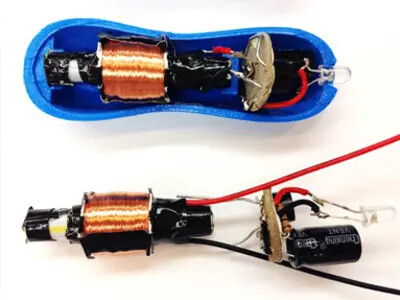


Engineering Projects Offer Students ‘Authentic’ Work Experience
A world of scientific discovery was opened up for a team of Raritan Valley Community College students when it had the opportunity to design a product for a client located halfway around the world in China. The product the student team developed and produced was a small, waterproof keychain light with no batteries or switches that could be turned on simply by shaking it.
It’s an experience most college engineering students can only dream of realizing.
The students participated in an Authentic Engineering Experience pilot course, a class focused on using industry-developed design and problem solving techniques to make a real product for a real customer. Under the supervision of RVCC Assistant Professor Peter Stupak, the students worked together to design the electromagnetic-induction keychain light, create the prototype, manufacture the product and deliver it to the customer in China, all while working on a tight deadline. The team included second-year Engineering students Ben Carlsen, Tyler George, Shayna Rumrill and Justin Suriano.
“The goal of the pilot course was to expose students, early in their academic careers, under ‘authentic engineering conditions,’ to vital skills and practices used daily in the industry. To accomplish this they had to create their own designs, experience their own failures and successes, learn to work as a team, navigate project management, resolve their own internal communications and scheduling conflicts, and respond to their customer’s critical comments about prototype product performance,” explains Stupak.
As part of the project, the student team designed and developed the shakelight’s induction power supply, energy storage and LED lighting circuit, as well as created a customized, 3D-printed package that even included the customer’s logo.
The team’s work was a great success, according to Stupak. When the professor met with the customer in China in January 2016, he was told, “The student team did excellent work and the improvements in the product performance since the prototype are remarkable! This is an excellent project. We are pleased to support this type of higher education.”
Thanks to the success of the students and the pilot program, this fall more students will get a chance to participate in the Authentic Engineering Experience. The course is being expanded to provide two to three teams with the opportunity to gain practical, industry-like experience.
In addition to the Authentic Engineering Experience pilot course, several RVCC students gained hands-on experience in scientific exploration during the 2015-2016 school year by participating in independent, Honors Capstone projects. All of the following student projects were supervised by Professor Stupak, with the exception of the first one:
- “Concentrating Sunlight to Improve Photovoltaic Cell Power” (Mike Krewsun, supervised by Professor Antonella Pompo): Constructing a four-foot diameter parabolic solar collector to concentrate sunlight and test the increase in electrical power of photovoltaic solar cells
- “Graphene Capacitor – Making and Using a New Material to Store Electrical Energy” (Matt Majorossy): Synthetizing graphene and using it to make a capacitor to store electrical energy and to illuminate an LED light
- “Environmental Plastic – Plastic Particle Size from Wave Action” (Ian Gallagher): Investigating the effect of wave action on the breakdown of plastics in the environment
- “Homemade Radio and Amplifier” (Trevor Rokosky): Building a radio from scratch—a “crystal radio” that uses the energy of the radio waves themselves to power the radio, with no external power from wall outlets or batteries—and also creating an amplifier
- “Fractal Mixing of Paint” (Mike Alirangues): Mixing paint using mixing paddles containing various types of holes, fabricating different mixers using a 3D printer, photographing the mixing pattern of black and white paint as a function of the number of mixing rotations, and analyzing the statistics of the extent of mixing using image analysis software




